Midpoint Reflection
https://canvas.instructure.com/courses/1288387/assignments/8024238?module_item_id=16052093
While it may take time to do this reflection, it can have many important benefits: 1) research shows that reflecting on experiences creates an environment in which insights and creativity can flourish; 2) taking a moment to consider the positive experiences (and to learn from the challenging ones) generates positive emotions which can benefit everyone during highly stressful moments in the semester; and 3) your experiences in narrative form provide insights to the committee beyond what is possible through surveys. This helps us to tailor the program in the future.
Here are a few questions/topics you should consider in your reflection:
- How well is the program working for you so far?
I was not able to collaborate last year, but this year it has been perfect match with my ID2ID buddy Aura Lippincott. It is just marvelous to work with same-minded and driven person
- What have you accomplished so far?
We are well underway with one of our two projects – the VRrelax one the project each of us is teaming up with faculty and staff from our universities. We plan to roll out the test at the end of this month (October), do the research in November and compare notes and results in December. The project aims to establish if VR delivered by Oculus Go may have positive impact on stress reduction for students.
Our second project, the Open Learning one is also gathering speed; we intend to have a research topic determined by the end of the month, while we are gathering resources at the time being.
- What else do you need to do? Describe the progress you have made toward meeting your program goals.
Each of us is in a daily contact with faculty and staff, searching for the right people to build a team. By mid September, we were able to start forming the research questions with the team and establish responsibilities and deadlines. We keep track of the progress via Google Docs: https://docs.google.com/document/d/1kOgqC7vUaBtOEDaB6ZF-ayEyVw2yBmB0fHXWrrcFkB4/edit and https://docs.google.com/document/d/1huFe1bPE08ha9acDLTsDkCz0blaxQ2bKKSxg97woGIY/edit
- What obstacles have you faced that you did not anticipate?
I have difficulty to pinpoint obstacles, because with a determined ID2ID partner and team members, all obstacles start to seem minuscules. We had discussions about the video content of the VR session, or the frequency of the testing and some of these issues is impossible to reconcile for two teams on different campuses, but again, they do not seem crucial when the team is driven by conviction to finish the research
- What are your plans for working through them? What are your plans for the rest of the program? Many of you may have chosen to focus on one or more of the ELI Key Issues. If so, briefly summarize and reflect upon your discussions of these key issues.
In regard of the ELI Key issues
https://er.educause.edu/blogs/2018/1/presenting-the-eli-key-issues-for-2018
I see our work falling neatly under: digital and information literacy. The work through ID2ID seems as a intake of fresh air, since digital and information literacy is not considered in the stagnant 90-ish interpretation, as myopically imposed in the library where i work. Our project aims to assert digital literacy as understood by Educause.
To some degree, our work also falls under the ELI issue of “learning space design.” While we advocate for virtual learning spaces, as well as under the ELI issue “academic transformation and faculty development.” Both XR and open learning are ambitious trends, which inadvertently can meet resistance with their novelty and lack of track in former traditional methods of teaching and learning.
When: October 24, 2017 2:00-3:00pm
Where: Adobe Connect meeting: https://webmeeting.minnstate.edu/oercommunityconversations
Who: Karen Pikula, Psychology faculty, Central Lakes College, and Minnesota State OER Faculty Development Coordinator
Special Guest: Gary Hunter System Director for Intellectual Property
Questions?
Feel free to contact Kimberly Johnson, Director of Faculty and Instructional Development at kimberly.johnson@minnstate.edu or Karen Pikula, Minnesota State OER Faculty Development Coordinator, at karen.pikula@minnstate.edu.
+++++++++++
notes from the webinar
Gary Hunter. copyright. movies, public performance rights, youtube videos. up
the compliance of the terms of service of the web site. Contract law. copyright law. system procedure – copyright clearance, clearing the copyright means using it without violating the copyright law.
clearing copyright:
- determine if materials are or are not protected
- use your own original materials
- perform fair use analysis with fair use checklist to usitify use
- use in compliance with sections 110 (1) & (2) of copyright act
- use materials avaialble through an open or CC license
- get permission (letter, email, subscription, license, etc.)
http://www.minnstate.edu/system/asa/academicaffairs/policy/copyright/forms.html
8 categories of copyright works
establishing copyright. eligibility requirements;
- fixation
- originality
- minimal creativity
when these three criteria met, copyright arises automatically.
registering a copyright https://www.copyright.gov/ . $35. 70 years for individuals and 95 for corporations or 210 years
not protected by copyright
- public domain (expired copyright/donated)
- federal gov publications and web site info
- works typically registered as a trademark
- tag lines and slogans
- just do it – nike 1988
- got milk – 1993
- math equations and formulas
- recipes
- blank forms
- phone books
copyright holder exclusive rights
- make copies of the work
- prepare derivative works
- distribute copies
- perform the work – performing live (band concert); pre-record audio visual of the same items. DVD play of a movie is considered “performing”
- display the work
legality vs reality
legality – activity may be copyright infringement from a legal point of view.
reality – tolerated or ignored by the copyright holder for various reasons
limitations on copyright
- fair use (#107). librarians use it a lot to copy. using copyright works in F2F teaching, scholarship, research and other non-profit ed purposes.
- criticism, comment, news reporting, teaching, scholarship, research
four factors to consider (not educational exception) ; it is a four part test to apply: 1. purpose and character if tge yse 2. nature of the copyirghted work (e.g. factual v creative) 3. amount
http://www.minnstate.edu/system/asa/academicaffairs/policy/copyright/docs/Fair_Use_Checklist1.pdf
http://www.minnstate.edu/system/asa/academicaffairs/policy/copyright/forms.html
fair use >> . transformation: 1. add / subtract from original 2. use for different purpose; >> parody songs – using enough of music and words to recognize the song, but not enough to it to be copyright infrigement. memes.
students’ use of copyrighted works. students may: use the entire copyrighted work but not publish openly
copyright act #110 (1) applies to F2F teaching.
copyright act #110 (2) applies to Hybrid/Online teaching. exception one digital copy can made and uploaded on D2L. reasonable and limited portions of dramatic musical or audiovisual works
http://www.minnstate.edu/system/asa/academicaffairs/policy/copyright/forms.html
personal use v public performance.
if people identifiable ask them to sign a media release form
plagiarism v copyright infringement.
Creative Commons (CC). search engine for content available through cc licenses. https://creativecommons.org/ CC BY – attribution needed; CC BY-SA may remix, tweak CC BY-ND can redistribute, but not alter CC BY-NC for non profit. CC BY-NC-SA
copyright questions
book chapters: one is a rule of thumb
PDF versions of the eassays textbook acceptable, if the students purchased it
music performance licenses: usually cover – educational activities on campus; ed activities at off-campus locations that are outreach
music licenses: BMI, ASCAP, SESAC
#201. Ownership of Copyright. Student ownership http://www.minnstate.edu/system/asa/academicaffairs/policy/copyright/forms.html
MnSCU board policy 3.26 intellectual policy. part 4, subpart A: institutional works; scholarly works; personal works; student works. MnSCU board policy 3.27.1: copyright clearance.
Gary.Hunter@so.mnscu.edu
++++++++++++
more on OER in this IMS blog
https://blog.stcloudstate.edu/ims?s=oer
Designing and Developing Digital Credentials
Part 1: September 13, 2017 | 1:00–2:30 p.m. ET
Part 2: September 19, 2017 | 1:00–2:30 p.m. ET
Part 3: September 28, 2017 | 1:00–2:30 p.m. ET
https://events.educause.edu/eli/courses/2017/digging-into-badges-designing-and-developing-digital-credentials
Digital badges are receiving a growing amount of attention and are beginning to disrupt the norms of what it means to earn credit or be credentialed. Badges allow the sharing of evidence of skills and knowledge acquired through a wide range of life activity, at a granular level, and at a pace that keeps up with individuals who are always learning—even outside the classroom. As such, those not traditionally in the degree-granting realm—such as associations, online communities, and even employers—are now issuing “credit” for achievement they can uniquely recognize. At the same time, higher education institutions are rethinking the type and size of activities worthy of official recognition. From massive open online courses (MOOCs), service learning, faculty development, and campus events to new ways of structuring academic programs and courses or acknowledging granular or discrete skills and competencies these programs explore, there’s much for colleges and universities to consider in the wide open frontier called badging.
Learning Objectives
During this ELI course, participants will:
- Explore core concepts that define digital badges, as well as the benefits and use in learning-related contexts
- Understand the underlying technical aspects of digital badges and how they relate to each other and the broader landscape for each learner and issuing organization
- Critically review and analyze examples of the adoption of digital credentials both inside and outside higher education
- Identify and isolate specific programs, courses, or other campus or online activities that would be meaningfully supported and acknowledged with digital badges or credentials
- Consider the benefit of each minted badge or system to the earner, issuer, and observer
- Develop a badge constellation or taxonomy for their own project
- Consider forms of assessment suitable for evaluating badge earning
- Learn about design considerations around the visual aspects of badges
- Create a badge-issuing plan
- Issue badges
NOTE: Participants will be asked to complete assignments in between the course segments that support the learning objectives stated above and will receive feedback and constructive critique from course facilitators on how to improve and shape their work.
Jonathan Finkelstein, CEO, Credly
Jonathan Finkelstein is founder and CEO of Credly, creator of the Open Credit framework, and founder of the open source BadgeOS project. Together these platforms have enabled thousands of organizations to recognize, reward, and market skills and achievement. Previously, he was founder of LearningTimes and co-founder of HorizonLive (acquired by Blackboard), helping mission-driven organizations serve millions of learners through online programs and platforms. Finkelstein is author of Learning in Real Time (Wiley), contributing author to The Digital Museum, co-author of a report for the U.S. Department of Education on the potential for digital badges, and a frequent speaker on digital credentials, open badges, and the future of learning and workforce development. Recent speaking engagements have included programs at The White House, U.S. Chamber of Commerce, Smithsonian, EDUCAUSE, IMS Global, Lumina Foundation, ASAE, and the Federal Reserve. Finkelstein is involved in several open standards initiatives, such as the IMS Global Learning Consortium, Badge Alliance, American Council on Education (ACE) Stackable Credentials Framework Advisory Group, and the Credential Registry. He graduated with honors from Harvard.
Susan Manning, University of Wisconsin-Stout
In addition to helping Credly clients design credential systems in formal and informal settings, Susan Manning comes from the teaching world. Presently she teaches for the University of Wisconsin at Stout, including courses in instructional design, universal design for learning, and the use of games for learning. Manning was recognized by the Sloan Consortium with the prestigious 2013 Excellence in Online Teaching Award. She has worked with a range of academic institutions to develop competency-based programs that integrate digital badges. Several of her publications specifically speak to digital badge systems; other work is centered on technology tools and online education.
EDUC-441 Mobile Learning Instructional Design
(3 cr.)
Repeatable for Credit: No
Mobile learning research, trends, instructional design strategies for curriculum integration and professional development.
EDUC-452 Universal Design for Learning
(2 cr.)
Repeatable for Credit: No
Instructional design strategies that support a wide range of learner differences; create barrier-free learning by applying universal design concepts.
+++++++++++++++++
more on badges in education in this IMS blog
https://blog.stcloudstate.edu/ims?s=badges
Tobin, T. J., Mandernach, B. J., & Taylor, A. H. (2015). Evaluating Online Teaching: Implementing Best Practices (1 edition). San Francisco, CA: Jossey-Bass.
- 5 measurable faculty competencies for on line teaching:
- attend to unique challenges of distance learning
- Be familiar with unique learning needs
- Achieve mastery of course content, structure , and organization
- Respond to student inquiries
- Provide detailed feedback
- Communicate effectively
- Promote a safe learning environment
- Monitor student progress
- Communicate course goals
- Provide evidence of teaching presence.
Best practices include:
- Making interactions challenging yet supportive for students
- Asking learners to be active participants in the learning process
- Acknowledging variety on the ways that students learn best
- Providing timely and constructive feedback
Evaluation principles
- Instructor knowledge
- Method of instruction
- Instructor-student rapport
- Teaching behaviors
- Enthusiastic teaching
- Concern for teaching
- Overall
8. The American Association for higher Education 9 principle4s of Good practice for assessing student learning from 1996 hold equally in the F2F and online environments:
the assessment of student learning beings with educational values
assessment is most effective when it reflects an understanding of learning as multidimensional, integrated and revealed in performance over time
assessment works best when the programs it seeks to improve have clear, explicitly stated purposes.
Assessment requires attention to outcomes but also and equally to the experiences that lead to those outcomes.
Assessment works best when it is ongoing, not episodic
Assessment fosters wider improvement when representatives from across the educational community are involved
Assessment makes a difference when it begins with issues of use and illumines questions that people really care bout
Assessment is most likely to lead to improvements when it is part of the large set of conditions that promote change.
Through assessment, educators meet responsibilities to students and to the public.
9 most of the online teaching evaluation instruments in use today are created to evaluate content design rather than teaching practices.
29 stakeholders for the evaluation of online teaching
- faculty members with online teaching experience
- campus faculty members as a means of establishing equitable evaluation across modes of teaching
- contingent faculty members teaching online
- department or college administrators
- members of faculty unions or representative governing organizations
- administrative support specialists
- distance learning administrators
- technology specialists
- LMS administrators
- Faculty development and training specialists
- Institutional assessment and effectiveness specialists
- Students
Sample student rating q/s
University resources
Rate the effectiveness of the online library for locationg course materials
Based on your experience,
148. Checklist for Online Interactive Learning COIL
150. Quality Online Course Initiative QOCI
151 QM Rubric
154 The Online Insturctor Evaluation System OIES
163 Data Analytics: moving beyond student learning
- # of announcments posted per module
- # of contributions to the asynchronous discussion boards
- Quality of the contributions
- Timeliness of posting student grades
- Timelines of student feedback
- Quality of instructional supplements
- Quality of feedback on student work
- Frequency of logins
- 180 understanding big data
- reliability
- validity
- factor structure
187 a holistics valuation plan should include both formative evaluation, in which observations and rating are undertaken with the purposes of improving teaching and learning, and summative evaluation, in which observation and ratings are used in order to make personnel decisions, such as granting promotion and tenure, remediation, and asking contingent faculty to teach again.
195 separating teaching behaviors from content design
+++++++++++++++++
more on online teaching in this IMS blog
https://blog.stcloudstate.edu/ims?s=online+teaching
2016 POD Network Conference
http://podnetwork.org/content/uploads/2016-POD-Program-Final.pdf
https://guidebook.com/g/pod2016
Studying Connections between Student Well-Being,
Performance, and Active Learning
Amy Godert, Cornell University; Teresa Pettit, Cornell University
Treasure in the Sierra Madre? Digital Badges and Educational
Development
Chris Clark, University of Notre Dame; G. Alex Ambrose, University
of Notre Dame; Gwynn Mettetal, Indiana University South Bend;
David Pedersen, Embry-Riddle Aeronautical University; Roberta
(Robin) Sullivan, University of Buffalo, State University of New York
Learning and Teaching Centers: The Missing Link in Data
Analytics
Denise Drane, Northwestern University; Susanna Calkins,
Northwestern University
Identifying and Supporting the Needs of International Faculty
Deborah DeZure, Michigan State University; Cindi Leverich, Michigan
State University
Online Discussions for Engaged and Meaningful Student
Learning
Danilo M. Baylen, University of West Georgia; Cheryl Fulghum,
Haywood Community College
Why Consider Online Asynchronous Educational Development?
Christopher Price, SUNY Center for Professional Development
Online, On-Demand Faculty Professional Development for Your
Campus
Roberta (Robin) Sullivan, University at Buffalo, State University of
New York; Cherie van Putten, Binghamton University, State
University of New York; Chris Price, State University of New York
The Tools of Engagement Project (http://suny.edu/toep) is an online faculty development model that encourages instructors to explore and reflect on innovative and creative uses of freely-available online educational technologies to increase student engagement and learning. TOEP is not traditional professional development but instead provides access to resources for instructors to explore at their own pace through a set of hands-on discovery activities. TOEP facilitates a learning community where participants learn from each
other and share ideas. This poster will demonstrate how you can implement TOEP at your campus by either adopting your own version or joining the existing project.
Video Captioning 101: Establishing High Standards With
Limited Resources
Stacy Grooters, Boston College; Christina Mirshekari, Boston
College; Kimberly Humphrey, Boston College
Recent legal challenges have alerted institutions to the importance of ensuring that video content for instruction is properly captioned. However, merely meeting minimum legal standards can still fall significantly short of the best practices defined by disability rights
organizations and the principles of Universal Design for Learning. Drawing from data gathered through a year-long pilot to investigate the costs and labor required to establish “in-house” captioning support at Boston College, this hands-on session seeks to give
participants the tools and information they need to set a high bar for captioning initiatives at their own institutions.
Sessions on mindfulness
52 Cognitive Neuroscience Applications for Teaching and Learning (BoF)
53 Contemplative Practices (BoF) Facilitators: Penelope Wong, Berea College; Carl S. Moore, University of the District of Columbia
79 The Art of Mindfulness: Transforming Faculty Development by Being Present Ursula Sorensen, Utah Valley University
93 Impacting Learning through Understanding of Work Life Balance Deanna Arbuckle, Walden University
113 Classroom Mindfulness Practices to Increase Attention, Creativity, and Deep Engagement Michael Sweet, Northeastern University
132 Measuring the Impacts of Mindfulness Practices in the Classroom Kelsey Bitting, Northeastern University; Michael Sweet, Northeastern University
+++++++++
more on POD conferences in this IMS blog
https://blog.stcloudstate.edu/ims?s=pod+conference
#MNsummit2015
Main speaker
Aaron Doering
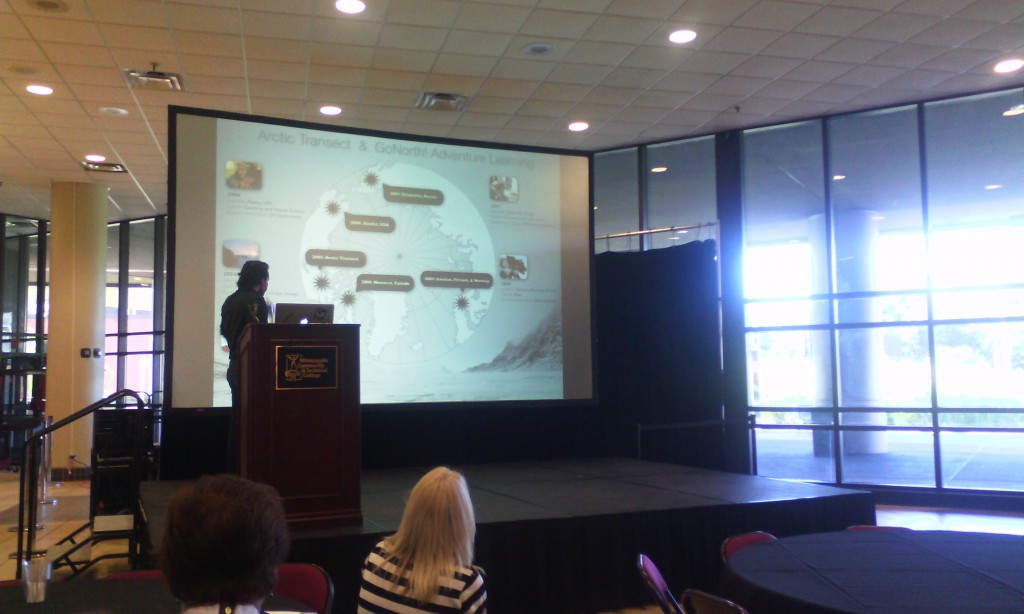
aaron doening
Engagement not completion
Design experience not product
Create change, not simply respond to it
He was a geography teacher : Dimitrina
Experience explore expand. Adventure based how to collaborate in ways we have not collaborated before pedagogical guidelines internet driven
Instructor – content – design
Today: first think is design, content, instructor. So how do we design learning environments is the most important one
Guide learners as designers. Constructivism. Design for meaning. Through the power of the story.
Geotetic design a learning environment learn geography using GIS
Situated movies (student-centered learning)
Grant Earthducation go to the most remote parts of the world to align their education with their culture, instead of what the government is downing as culture
Use of phone: whoever answers instructor’s question first, gets to pose the next question to the rest of the audience.
Design based research
Self-narrative, referencing the experience real world issues in real time
- reference knowledge . knowledge overlap. Technological pedagogical content knowledge.
Geotetic not only how prepare teachers, but desing learning environmwer of the story.
we explore: https://www.we-explore.com/
9.5 design as a learner.
the U Media Lab.
The Changing Earth. App GoX (instagram on steroids. tell their story through the app). How is this different from Google Earth
Raptor Lab (rehabilitate a raptor).
- design experiences
- build trust
- guide learners as designers
- recognize learners as experts
- encourage collaboration
- inspire self narrative
- reference the knowledge domains
- teach for change
- design as learner
adoering@umn.edi chasingseals.com @chasingseals
podcast pontification (audio version of blog self reflections)
Greg Steinke The U
A Digital Story Assignment using WeVideo

WeVideo is the Google response to iMovie cloud
The U is on Google email and thus google drive and all other google tools
The Center for Digital Storytelling. short videos, 3-5 min incorporate photographs with the author narration, reflection
Assignment (verbal directions). process (write a 2 page script, every page is about a minute of video), gather images that support the story; edit the script (rewrite); record audio to the script (use an app on the phone instead of WeVideo), WeVideo can edit the audio recording; edit the story, edit the photos to match the story; YourTube and/or Google+
working with faculty: is the digital story a good fit for your course? two questions: does the course have many writing assignments? does everyone have to do the same type of assignment? do you want to offer choices? do you want your students to share their work outside of the class? to you want to explore opportunities for students to develop 21 century skills?
google communities for sharing
wewideo has a tutorial at Center for Digital Storytelling
students can use the digital story for their eportfolio
the entire exercise is entirely based on mobile devices
time frame: scaffolding options
3d printing products were the tangible result of the project and the digital storytelling just the format to present
Google Drive master folder for the phone images and video; iOS apps: MoviePro, FiLMc Pro, VoiceRecord Pro (including mp3); Android: WeVideo
Storyboard template
Faculty Development Programs: Digital Storytelling Community of Practice
http://it.umn.edu/faculty-development-programs-digital-0
Poster sessions:
Brad Hokanson
http://dha.design.umn.edu/faculty/BHokanson.html
iPAD video kit:

Laurie Conzemius
Critical Thinking

ISTE: http://conference.iste.org/2016/
Joe Lau critical thinking
apps: Popplet blog.popplet.com http://www.popplet.com/ (mindmapping)
into the book: http://reading.ecb.org/
Kahoot – the token system. Polleverywhere https://blog.stcloudstate.edu/ims/2015/05/21/polls-and-surveys-tools-for-education/
Symbaloo https://www.symbaloo.com/home/mix/13eOcK1fiV zotero, easybib, delicious, diigo depending on the grade
youth voices; http://youthvoices.net/ replace social media like teachertube is trying to replace youtube
quandary games in education. https://www.quandarygame.org/ sim city
citizen science alliance http://www.citizensciencealliance.org/
Toontastic https://itunes.apple.com/us/app/toontastic/id404693282?mt=8 now free storytelling
coding and programming: https://www.makewonder.com/robots/dashanddot scratch
Osmo : https://www.playosmo.com/en/ $79.99 + give a set for free Stride principle as a parental involvement
chainlink;
kickword; https://play.google.com/store/apps/details?id=com.makario.wordkick
red herring (four categories) https://play.google.com/store/apps/details?id=com.BlueOxTech.RedHerring&hl=en
http://www.mathplayground.com/logicgames.html
http://www.mathplayground.com/thinkingblocks.html
evaluation:
telestory https://itunes.apple.com/us/app/telestory/id915378506?mt=8
explain everything http://explaineverything.com/
Exploring and Connecting 3D Printing to Teaching and Learning Jason Spartz, Saint Mary’s University of Minnesota
http://pubs.lib.umn.edu/minnesota-elearning-summit/2015/program/23/
http://pubs.lib.umn.edu/cgi/viewcontent.cgi?article=1023&context=minnesota-elearning-summit
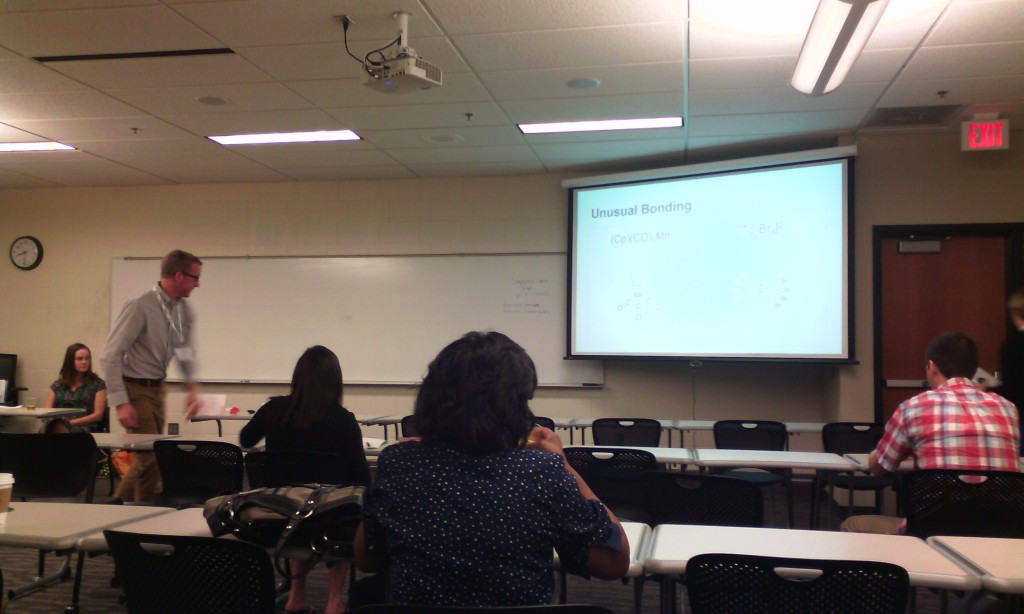
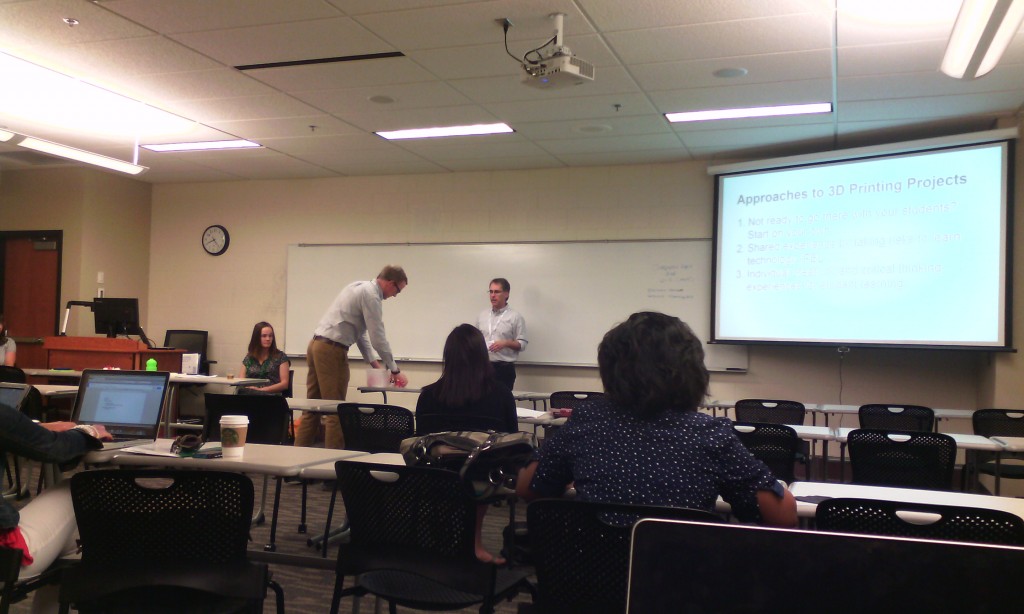
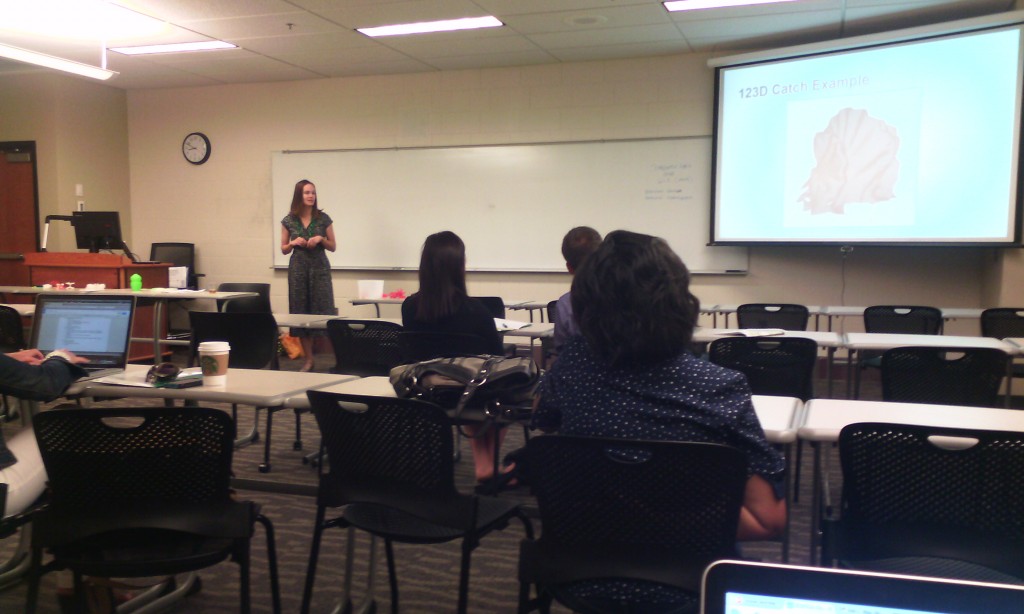
Jason Spartz, Saint Mary’s University of MinnesotaFollow
Lisa Truax, Saint Mary’s University of MinnesotaFollow
Karen Sorvaag, Saint Mary’s University of MinnesotaFollow
Brett Bodsgard, Saint Mary’s University of MinnesotaFollow
chemistry professor. 3D printing with different materials.
what else can be made (e.g. reaction vessel)
printing of atoms
crystalography dbase
Karen: pre-service teachers professor: how to use 3d printers and be comfortable with them. Steve Hoover. Thinkercad and Autodesk123D>
3D academy http://www.team3dacademy.com/index2.html. Pinterest board for3d Printing with resources
Lisa: graphic design. not intuitive. Rhinoceros (not free anymore). 123D strong learning curve. 3d printing will be incorporated in the curriculum. sculpture students and others don’t like fudging on the computer, but Adobe people love it. Some items takes up to 4 hours to print out. when working on the computer is difficult for some students to visualize the dimensionality.
collaborative learning opportunities.
no makerspace or fab lab. additional interest from the theater and business dept. 3d printing is connected to future work skills. new media ecology or media literacy set of skills.
the main presenter: build excitement and interest and gradually step back. how much material goes through and should we charge back. clean and maintenance involved; not too bad. better then a copier. plastic inexpensive. sizes with plastic – $25 and $50. how many project of a spool: depending on the size of the projects but considerable amount. two printers one art dept and one in the faculty dev area.
non profit visually impaired students. how 3d can make difference in special ed.
3d printing lab with access for everybody. ownership brings policy. where housed: neutral place.
only one printer is barely sufficient for faculty to figure out how to use it. purchasing two more if students and curricula to be involved.
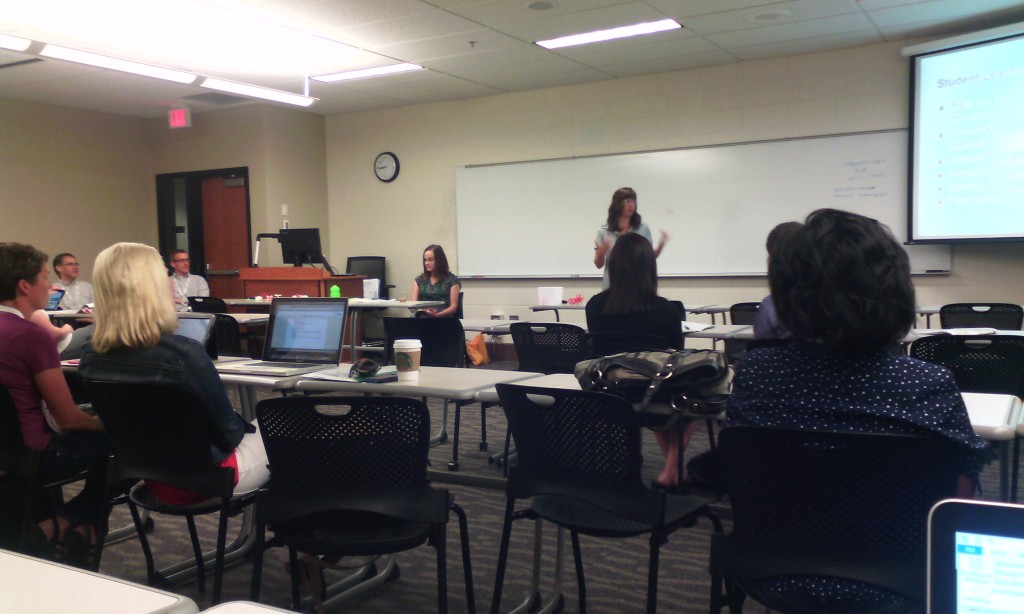



The Balancing Act: Team-Creating an eBook as an Alternative Method for Content Delivery Tom Nechodomu, University of Minnesota

Faculty Created digital stories – google “cultivaitng change series”
student created digital stories –
Susan Andre uses a slide titled “trust” to elucidate how the entire project was enabled. “trust” and “transparency” are sparse currency in the environment I work in. if she is right an ebook ain’t happening anytime soon at my place.
inclining habitat.
students involvement. use stipends. student artists. food for the video interviews. create a community, student centered.
people able to change the book.
copyright process; did you find it cumbersome. copyright permission center.
time span and amount of hours spent: 3-4 months per chapter.
Main speaker
David Wiley. Making Teaching and Learning Awesome with Open
MN Learning Commons
open educational resources
LUMEN
education – sharing feedback, encouragement with students passion about the discipline, yourself
open is not the same as free. free + permissions + copyright permission: 5 r = retain (make and own copies), reuse (use in a wide range of ways), revise (adapt, modify, and improve), remix (combine two or more), redistribute (share with others)
open:
free and unfettered access
perpetual, irrevocable copyright permissions
(look but don’t touch is not open)
tech enables OER permits
traditionally copyright materials on the Internet – not so good ; jet on the road
openly copyright materials on the internet _ yes: jet in the air
permission-less innovation. relatively inexpensive and broad permissions.
intellectual infrastructure of education: learning outcomes/objectives; assessments; textbooks. they are relatively expensive and narrow permissions.
disappearing ink strategies: buyback, rental, ebooks, online subscription
mad, glad, sad, rad: the grumpy cat. student success per dollar
opennetgroup.org/review
change in student learning: replace commercial with open books – small. realign, bigger change. rethink is the large change.
responsibilities:
attribution and meeting other license requirements
thin common cartridge: a way to bring the content to the CMS, but the content remains on the creative commons
disposable assignment: students hate doing them, instructors hate grading them. waste of time and energy
so what?
open education infrastructure: open outcomes, objectives, activities, educational resources
the culture of glued legos must be eradicated. open pedagogy. open credentialing model
summary: don’t settle for “affordable.” improve student outcomes. improve affordability. improve design / academic freedom
links generated from the discussion at my presentation:









